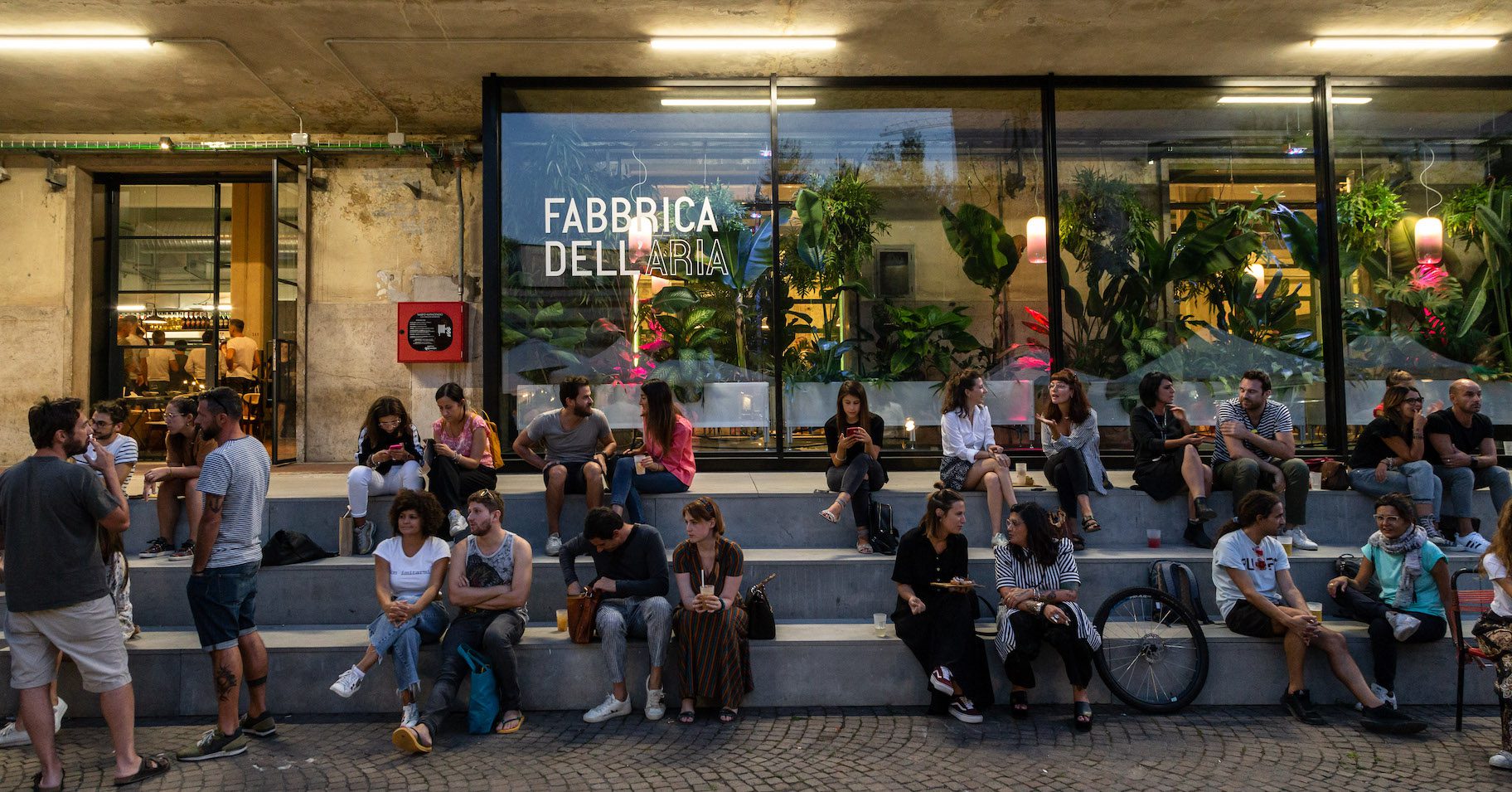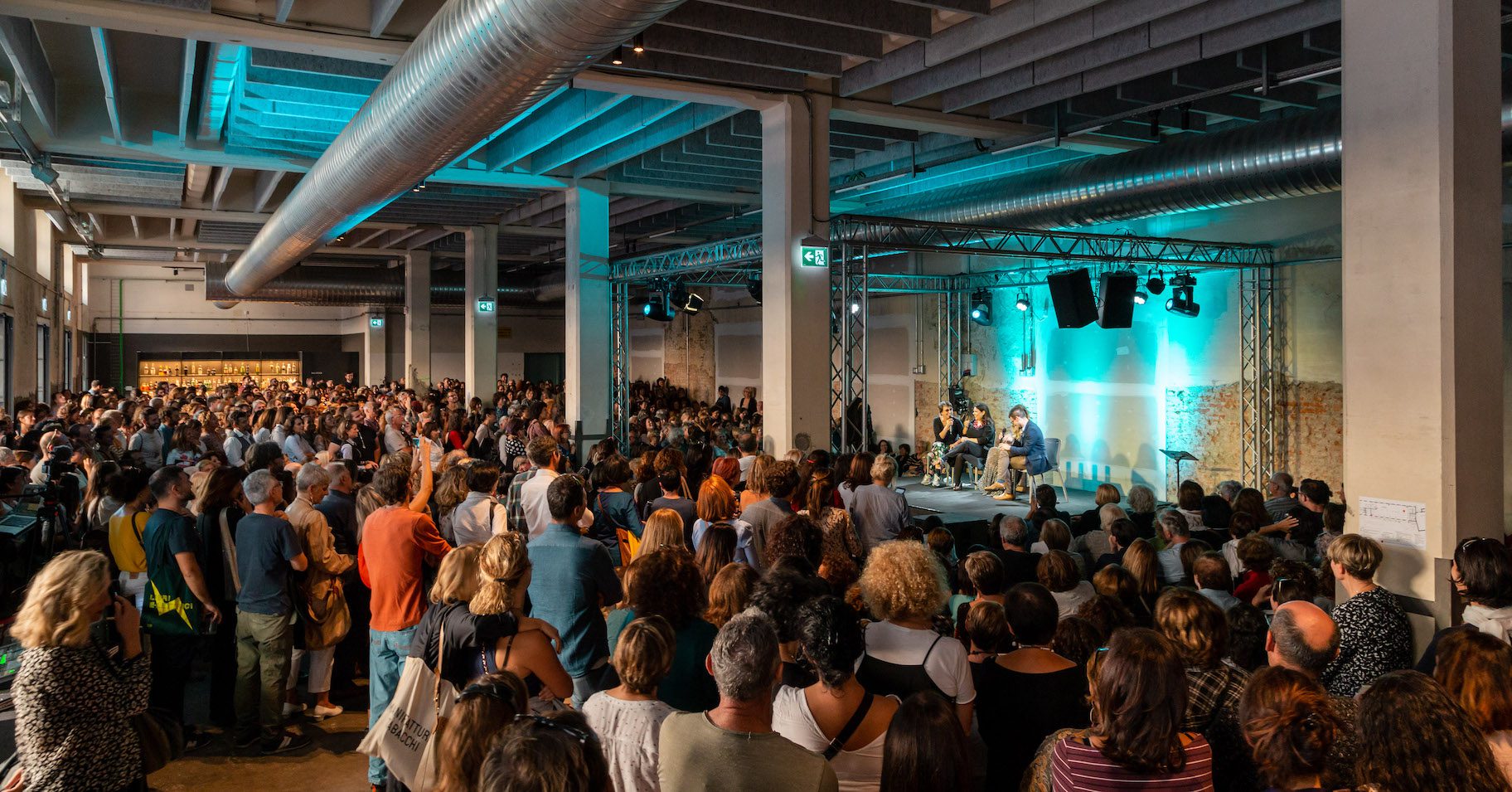Dario Marmo, the project manager at social company LAMA (Italy), says that it definitely is: he and his team have spent the last five years working on the largest project of this type in the Toscana region, whose uniqueness stands out in the entire Italy. The project’s goal is to transform an abandoned complex of a tobacco factory in Florence into an arts, business and leisure centre that is pulsating with life. The kind of centre that would set a new tone for a city that “keeps looking back to the past” and would give it a new focus: to look towards the future. As the Manifattura Tabacchi conversion period (2016-2026) is approaching the end, the feedback from Italians themselves and from the international community shows that the pursuit of ambitious goals has been going truly well. And the key to success has been the opening up of the area and buildings for temporary activities.
110,000 square metres for creative industries
The 6-hectare area of Manifattura Tabacchi, which consists of 16 buildings, is just 1.5 kilometres away from the historic centre of Florence, which draws in enormous numbers of tourists every year. Today, this is the place where the largest conversion and regeneration project in Florence’s history is being implemented. A huge state factory of cigarettes and cigars was opened here in 1940 and operated for about half a century; during its most intense production year, it had about 2,500 employees. Thus, for most of the 20th century, the factory was not only an important employer of the city but also the symbol of the community; for many older residents of Florence, it still evokes certain associations that are intertwined with nostalgia and a sense of loss.
In 2001, the factory was closed down due to the sharp decline in the demand for cigarettes. For over a decade, it remained abandoned. Only in 2016, when the factory’s territory and its entire infrastructure were purchased by an investment fund that had decided to invest about 250 million euros in the locale’s revival, the factory started transforming from a grey dot on the city’s map into a new hotspot. Ambitious conversion work was initiated: in addition to building new structures, the rationalist-style buildings already present in the area were renovated and adapted for new needs. The territory, which covers over 110,000 square metres, underwent a reconfiguration, which resulted in new squares, streets, and pedestrian zones. Interestingly, the area of the factory itself, which was designed by the architect Pier Luigi Nervi, is known for its architectural elegance and is considered to be an excellent example of Italy’s rationalist architecture. Thus, the local conversion was done while aiming to preserve the unique character and historical essence of the place, but also adding completely new enhancements: elements of contemporary art, fashion, science and the old trades that had become relevant once again. These elements were introduced via various temporary activities.
Temporary activities: a way to create a location’s image
Temporary activities are a practice which is used in city spaces that are being revived: usually, the kind of areas that are undergoing implementation of significant changes. Typically, the transformation work takes decades, therefore, a certain “waiting” time emerges. For this period (of a year or several years), temporary activities are conducted in the territory that aim to not only bring life back to the abandoned, forgotten zones, and to seek and establish a new local identity, but also to test the scenarios for activities of the companies and organisations that will operate here, and to attempt to attract target audiences.
During the waiting time, temporary activities can become great experimental platforms for social innovation that aid in the implementation of large-scale investment projects by gradually introducing them into the environment and giving everyone an opportunity to become a part of the changes.
These activities change the territory’s image and increase its attractiveness as an investment. Artists, creators and youths are drawn in, local demographic and social challenges are tackled. Moreover, the activities become an instrument of dialogue between local communities and the conversion’s implementers, helping to foresee future conflicts or more effectively solve the already existing ones; they also create partnerships between various interest groups and sectors.
In Lithuania, one of the examples of new applications of the temporary activities model is the Kaunas Fortress Park located on Lakūnų Road in Kaunas.
Florence’s example: fleshed-out business model and increased investment attractiveness
To coordinate the project of the implementation of temporary activities in 2018-2023, the company that conducted the conversion of Florence’s tobacco factory hired an external service provider, LAMA agency; because of the project’s large scale, the latter established a sub-division for the project’s management, Made in Manifattura (MIM). The agency closely coordinated all of its activities with the implementer of the tobacco factory’s conversion, which provided most of the funding for the agency.
“One of the biggest challenges for our team was to manage an object of such a scale and to thoughtfully and strategically bring back its relevance while at the same time transforming the image of the former factory’s territory. You see, it was an already well-known place: people say that today you couldn’t find a second-generation Florence resident who does not have any relatives or acquaintances that once worked at the factory. Thus, on one hand, the factory was very well-known; on the other hand, for many years, it stood abandoned and empty behind closed gates, and became a kind of a hole on the city’s map. Notably, there had been attempts to use it to an extent, for instance, by organising one-off fashion events (e.g. by the Florence-based Gucci and Fendi fashion houses). However, they were very short-term and elitist; they did not reach the wider masses and did not incite change”, Dario Marmo, LAMA associate, initiator of the temporary activities’ projects, said, recalling the beginning of work with the MIM group.
Therefore, when they kicked off their work, the Italians first targeted the wider masses and expanded the concept in order to turn the factory’s territory into an open space for all. The first year of work was particularly active: everyone from the youngest to the oldest were invited to continuous events, including the families living in the neighbourhood and the residents of Florence’s farther districts as well as the factory’s former workers. All of these audiences were offered various activities, most of which were free-of-charge: e.g., digital laboratories for children, a large variety of workshops, lessons, and various lectures, gardening and development of the city’s green zones, courses on ceramics or woodworking; frequently, their lecturers or teachers were the artists or craftspeople who conducted temporary activities in the factory’s territory. Not to mention the concerts, exhibitions, as well as the coffee shops that were busy from the morning to the evening, and the wide variety of tradespeople and creators who had established their own workshops and artist residencies.
“This way, Manifattura gained a completely new look: the revived spaces of the former factory started receiving crowds of entire families who enjoyed good food, played and spent leisure time together. This is a place that is visited by both the senior citizen who lives across the street and by the foreigners who are studying at the international fashion university Polimoda. Thus, the project is intertwined with the everyday life of the locals and with the life of the entire Florence, because the area became interesting and relevant not only for the nearby neighbours, but also for the entire city. All the more so because Florence is not large, so every event of greater interest at this location draws in visitors from various districts”, Marmo explained.
Naturally, there were experiments as well: for instance, 2019 was the year of electronic music concerts; the factory’s area was filled with sounds of techno and rave. Nevertheless, the idea was abandoned because it did not satisfy neither the territory’s developers, who were focusing on a slightly different audience, nor the concerts’ attendees nor the nearby residents, who did not appreciate the noise at all.
Transforming the city and the mindsets of its people
Over time, MIM metamorphosed from an organiser into simply an activity-curating platform, a host who brings communities together under one roof and whose activity proposals come from the lessees and external organisations that are based here. Gradually, a community was created at the location itself: today, it consists of over a thousand people who work, study, and live here. There are also many more clients, audiences and city dwellers who simply spend leisure time here and visit the place every week. After completing the project, Manifattura will be capable of welcoming up to 7,000 visitors.
Dario Marmo noted that, by drawing attention to this object, by creating a hotspot in it and bringing the entire district back to life, the organisers have also created tangible material benefit: the place’s prestige and investment attractiveness were increased, as well as the demand for and value of the property located here.
“However, most importantly, we have brought new energy into the life of the entire Florence; we have shown how the city could host more activities and initiatives. I think that the change created by Manifattura and the temporary activities of such a type in general is, above all, cultural: it changes not just the city but also the understanding of what we can do in it and how. We made people think about things that perhaps did not even cross their minds before”, said Marmo, who is also an expert participating in T-Factor, an international project dedicated to the analysis of temporary activities.
Italians’ advice to Lithuanians: if you want results, build networks
The international project T-Factor is the Horizon 2020 Innovation Action program dedicated to the promotion of temporary activities for urban regeneration. The specialists working on the project aim to highlight that, in the urban regeneration process, time should become a resource that can be used for strategic prototyping of future permanent activities.
According to Marmo, who is a member of the T-Factor team, Lithuania has all the conditions necessary for the development of participatory urbanism: especially in the urban territories that are regenerated by temporary activities. However, perhaps not all project developers or object owners understand their benefits and the wide opportunities that are opened up.
“Yes, temporary activities indeed most often become a platform of culture promotion and generate social change; but that is not all: as shown by the example of Manifattura, it is possible to very organically align the interests of both the city’s communities and the object’s developers, be it private business, a research institution, or the municipality. After finding common ground and by looking for what is valuable to all sides, we create a narrative, generate debate, incite interest, and, above all, we build more attractive physical spaces for people to live and be in. Also, temporary activities become a great training ground for determining which activities would be appealing there and to whom. By doing this, you will draw in people who will provide added value to the space and perhaps even become potential clients”, Dario Marmo pointed out.





